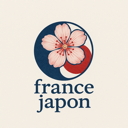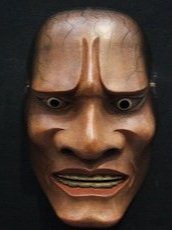Nous publions aujourd’hui en anglais (une fois n’est pas coutume) la présentation d’un artiste créant des masques de Noh.
https://www.nohmasks.net/noh-mask-spirit-gallery (photos des masques de Noh)
Les autres liens vers son site web sont au bas de l’article.
Noh Masks, Martial Arts, and Myself
Three major motivations pushed me to undertake the sculpture of Noh masks. My main reason for making Japan my new home in 1973 was to practice martial arts or Japanese martial traditions. My idol at that time was of course Miyamoto Musashi, the famous Japanese fencing genius.
I was reading diligently the book he had written about his vision and philosophy of Budo « Gorin No Sho » or « The Book of Five Rings, » but also on what his life had been. Miyamoto Musashi at 40, had already reached celebrity regarding his sword technique called Niten Ichi Ryu. But you have to know that Musashi was also a well-known artist, leaving behind him many works of art, including calligraphy, ink painting, and sculpture. He even founded a school of blacksmiths of Tsuba (Katana Guard). I asked myself what could be the source of this creative energy: what could cause a person to become a supreme warrior and an accomplished artist at the same time ?
I grieved that I would never be able to emulate such a person because I thought I did not know how to create something with my own hands. I had always envied sculptors, craftsmen, and carpenters, who could use their hands to create a piece of art. I felt quite like having some kind of invalidity and I suffered from it. This is undoubtedly this feeling of incapacity, an inferiority complex which was the first of my motivations for starting to carve Noh masks.
The second motivation comes from my attraction, my affinity for this warm material that is wood, this exciting element which, in the martial arts, made me love the art of the stick and its ancient techniques.
The third motivation is my fascination for masks in general and those of Noh in particular. I must say that the first ten years of my life in Japan were only devoted to the practice of martial arts and that the Noh theater was far from my concerns. The Noh theater was quite foreign to me and I never laid eyes on real masks of Noh, only the vulgar imitations found in the souvenir shops for tourists.
It was during my first visit to an exhibition of old masks of Noh that I had some kind of revelation. I was fascinated by the depth of their expressions, and that fascination has never left me since. As I was and still am an avid collector of antiques and vintage art objects, I would have liked to add a mask to my collection, but as you know, these masks rightly are very expensive. And it seemed difficult to acquire any authentic ones.
It was then that the idea came to me that I should seek a master who would teach me the techniques of their creation, and luckily enough I found a master quite rapidly. I started carving Noh masks 30 years ago. My knowledge of Japanese culture has deepened since then thanks to this passion, and I understand better the Japanese aesthetic approach of beauty by comparison with that of Europe: Greek and Roman antique beauty. To summarize simply, the aesthetic concepts of beauty in Europe and in Japan differ widely. In Europe, regularity, symmetry, and decoration are preferred, while in Japan, we cultivate asymmetry, irregularity, and simplicity as a measure of perfection.
The masks of Noh are to me not only aesthetically the most beautiful masks of the world, but they contain within them a spiritual force that speaks directly to our soul. Through carving Noh mask, I was able to get in touch for the first time with the Japanese aesthetic concept of wabi-sabi (rustic beauty) and the world of yugen (subtle grace) that we also find in Japanese martial arts. My interest in Noh masks expanded naturally and gradually to the Noh theater. By reading the contents of a few Noh plays, I realized that it concentrated in itself all aspects of Japanese culture, whether it is craftsmanship, classical literature, religion, history and popular beliefs. Noh masks recently have become a work of art in their own right through amateur mask carvers, and have taken up in my eyes their rightful place, as it has always been: an integral and inseparable part of the world of Noh.
To express this from a different angle, a mask can not be intended as a mere object of decoration, since it expresses in itself the history of the play in which it is used, and its expressions are directly related to the sentiments and narrative displayed in that particular Noh play. The mask is the central object of any Noh play. I became aware that Noh masks conceal within them the entire spectrum of Japanese cultural elements from which Noh theater takes its roots, and that if I wanted to improve myself and have a better understanding of the expression of my masks, I had to study the Noh plays too. It’s actually a bottomless well (Mugen) which has taken me to the study of Japanese classical poetry, Buddhist and Shinto religions, along with popular beliefs and the history of the Japanese classical era. I invite you to join me on this mystic journey into Japanese culture and spiritualism through my painstakingly carved Noh masks and Noh Mask Stories.
Roger Voltz — Profile
1948: Born in Saint-Denis in the suburbs of Paris.
1971: Graduated from the University of Paris
Faculty of Economics Sciences.
1973: Arrived in Japan to study Martial Arts at the Yoseikan Dojo under Master Minoru Mochizuki (Aikido and Ancient Japanese Martial Arts) and under Master Teruo Sano (Karate and Ancient Okinawan Martial Arts).
1992: Met Master Noh Mask Sculptor “Mugen” Atsumi Kichinosuke. Began sculpting Noh masks under his supervision.
2005: Founded the Shindoryu Bojutsu school of Bojutsu stick arts, becoming its technical director.
2005: Departed Japan for Tahiti to teach Bojutsu to the students of Papeete aikido club.
2006: Individual exhibition at Shizuoka gaz gallery.
2007: Group exhibition with the students of master Mugen at the Shizuoka Prefectural Museum.
2008: Exhibition of my works in collaboration with those of master Mugen at the Center department store in Shizuoka city.
2008: Individual exhibition at the Shizuoka Prefectural Museum.
2010: Group exhibition with the students of master Mugen at the Shizuoka Prefectural Museum.
2012: Group Exhibition at the Shizuoka Prefectural Museum with the students of master Mugen.
Liens vers le site web de l’artiste :
https://www.nohmasks.net/noh-mask-spirit-gallery (photos des masques de Noh)

